| The Very Highest Quality Coins... |
| Portraits of British Kings & Queens |
|
|
Ethelred II was perhaps unfortunate to earn the epithet "The Unready". His reign, 978 to 1016, occurred at a time of fierce raids by the Danes, who extracted large financial contributions from the English known as Danegeld. Much of this was paid in silver pennies similar to the coin we illustrate. To this day, silver pennies of Ethelred II occur more frequently in Scandinavia than in Britain. |

|
|
Edward the Confessor reigned from 1042 to 1066, and was one of the last Anglo Saxon kings of England. He was the son of Aethelred II ( The Unready) and Emma of Normandy. The coin we illustrate is a short cross, small flan type. |
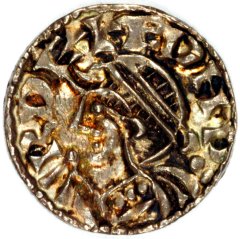
|
|
Harold II was the famous loser at the Battle of Hastings in 1066, being shot in the eye by an arrow. In his short reign from January to 14th October 1066, there were three types of silver pennies issued. |
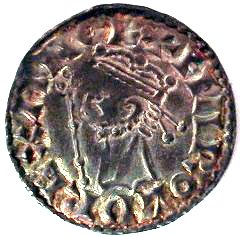
|
|
Now for the winner. William the Conqueror is famous as the victor at the Battle of Hastings, the last successful invader of England, and for ordering the Domesday Book. He is shown here on a "Bonnet Type" silver penny. |
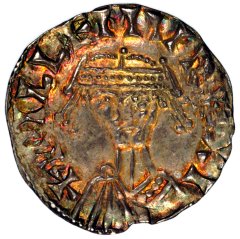
|
|
Henry III reigned from 1213 to 1272. His early coins followed the general style of medieval coins, and were mainly silver pennies. From 1247 a fresh coinage was issued because the existing coins were in a poor state through both wear and clipping, the practice of shaving off silver from the outside edge of the coin. The newly designed pennies had the cross on their reverse side extended to the edge of the coin to help to prevent clipping. |
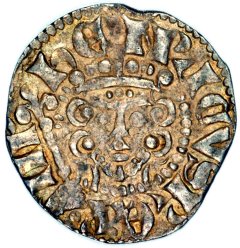
|
|
Edward reigned from 1272 to 1307, but for the first eight years of his reign his coins bear the portrait and name of Henry III. From 1279 there was a new coinage which included the first groat or fourpence. Our illustration is of a silver penny, which was the commonest currency of its period. |

|
|
Henry VI reigned from 1422 to 1471, but his reign was interrupted by a period from 1461 to 1470 by the first reign of Edward I. The coin illustrated is a groat, the largest silver coin of the period, and is from the first part of Henry's reign. |
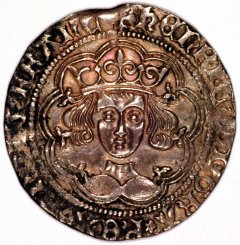
|
|
Henry VII was a great king, who brought Britain out of the middle ages into the renaissance period as a great nation. Amongst the enduring evidence of this is the changes to the coinage. Henry introduced the gold sovereign, which was also the first pound coin, and the testoon, which was the forerunner of the shilling. The innovative feature of the testoon was the profile portrait it bore compared with the crude full face portraits on its medieval styled predecessors. The groat, or fourpence, which we illustrate here also shared this profile type portrait. |
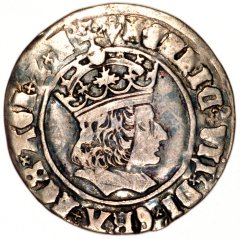
|
|
Henry VIII must be the most famous or perhaps infamous of British kings, reigning from 1509 to 1547. We show him here on a silver groat. Note the fleur-de-lys mintmark. |
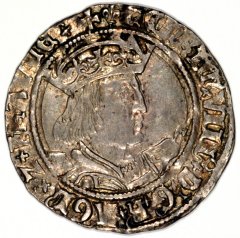
|
|
There were at least four different coin issues during the brief, six year, reign of Edward VI. His early coins continued to be debased like those of his father Henry VIII, but later the fineness was restored. Our featured coin is a sixpence from the last issue with a facing portrait. The tun mintmark tells us this was struck in London. |
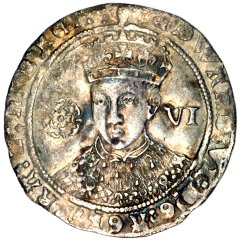
|
|
Mary reigned alone from 1553 to 1554, then jointly with her husband Philip Hapsburg of Spain, the son of the Emperor Charles V, until 1558. The metal content of the coinage was restored in Mary's reign. Our photograph shows a groat, the largest silver coin issued during Mary's sole reign. |

|
|
During the reigns of Charles I, Nicholas Briot used machinery to produce many fine coins. The engraving on this sixpence is an excellent example of the high quality of portraiture produced under Briot. |
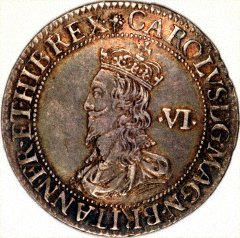
|
|
We have shown two portraits of Charles I to compensate for the untimely removal of his own head. This is a silver half pound or ten shilling coin dated 1642. The horseman is shown trampling on arms, as a celebration of victory. |
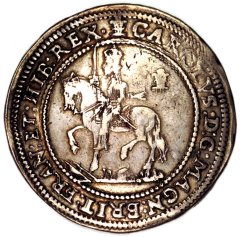
|
|
Cromwell became a king in all but name, and his head appeared on coins of the Commonwealth or Protectorate from 1656 to 1658. The coin shown is a broad, which at twenty shillings was the forerunner of the guinea. All Cromwell's coins were struck by the machinery of Pierre Blondeau from dies engraved by Thomas Simon. Some believe that all were intended as patterns, but some coins are known to have circulated. |
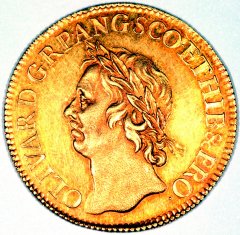
|
|
The monarchy was restored in 1660, and Charles II reigned until 1685. During his reign, the process of change from hand hammering of coins to machine production, also known as milling, was completed. The coin shown is a milled silver crown. |
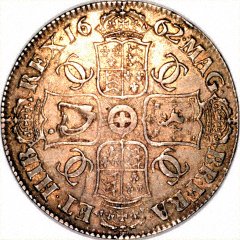
|
|
Wiiliam of Orange was invited by a group of seven British notables to invade Britain which he did in the name of his wife Anne, the daughter of James II. Pictured is a halfcrown showing the conjoined heads of William and Mary, used during their joint reign from 1689 to 1694. |
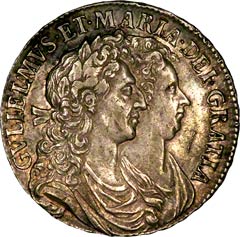
|
|
After the death of Mary, William II continued to reign until 1702. He became less popular partly because of the cost of continuing European wars which lead directly to the establishment of the Bank of England in 1694. |
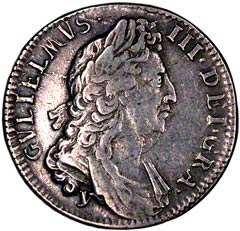
|
|
Anne reigned from 1702 to 1714, and during her reign, the Act of Union formalised the unification of England and Scotland which had effectively taken place during the reign of James I of England. |
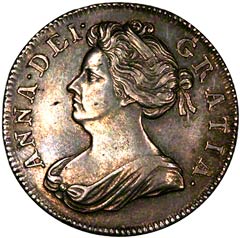
|
|
George II's reign lasted from 1727 to 1760. Many of the coins from this reign were minted from gold or silver captured by the East India Company and various privateers, and the origin of the bullion is often shown by corresponding marks under the portrait. Our coin shows the young head portrait on a shilling. |
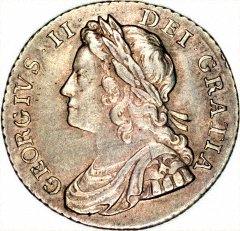
|
|
As with many long reigning monarchs, the portrait was changed after a number of years to reflect a more mature ruler. Our half guinea which is dated 1759 bears the old head portrait which was introduced in 1746. There was also an intermediate head similar to the old head design which was used from 1739 to 1745. |
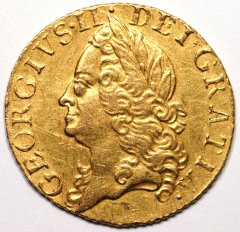
|
|
George III reigned from 1760 to 1820. Copper coins such as the halfpenny shown here were not produced in sufficient quantities to meet the demand for small change. |
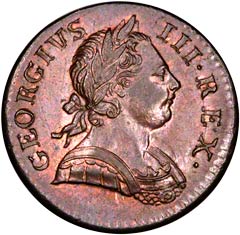
|
|
In 1816, the Royal Mint moved to a new site at Tower Hill in London, and there was a complete revision of the coinage, using the steam powered presses which had been developed by Matthew Boulton and James Watt. We show a silver crown with a fine engraving of the king by Benedetto Pistrucci. |
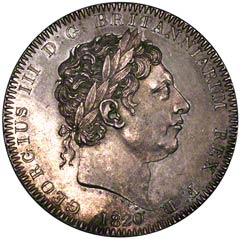
|
|
This photographs shows the first portrait type of a large laureate head on a gold sovereign of 1824. |

|
|
George IV's reign lasted from 1820 to 1830. Two main portrait styles were used. A large laureate head was used from 1821 to 1826, and a bare head from 1825 to 1830. Our coin shows a halfpenny which were only issued with the bare head design.. |

|
|
During the reign of William IV, there was only one obverse design used on the coinage, as shown in our photograph of a gold sovereign. |
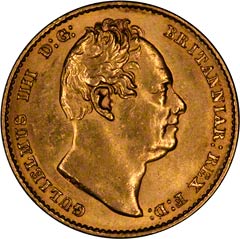
|
|
Queen Victoria reigned form 1837 to 1901. Because of the length of her reign, a number of different portraits were used. The young head portrait as shown on a gold sovereign was in use from her first coins in 1838 until 1887 on silver and gold coins, but continued in use until 1893 on bronze coins. |
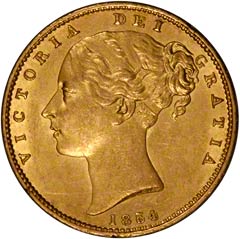
|
|
From 1860, copper coins were superseded by bronze coins. The young head portrait of Victoria also changed numerous times during its time. Our photograph shows a bronze farthing of 1881. |
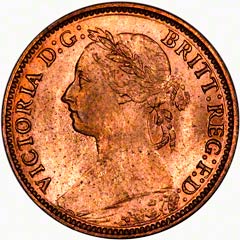
|
|
The very ornate gothic style portrait was used on the new florin denomination which was introduced in 1849, and also on the gothic crowns of 1847 and 1853. Our photograph shows a rare proof pattern of 1848 for the very first issue of "Godless" florins which lasted for only the one year 1849, before being replaced by the gothic florins with revised legends. |
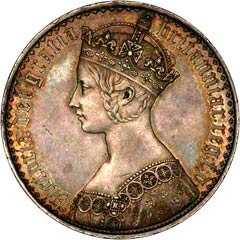
|
|
For Queen Victoria's golden jubilee celebrations in 1887, the obverse designs were changed to the familiar "jubilee head" portrait, which was used in gold and silver coins from 1887 to 1893. |
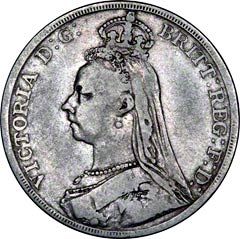
|
|
The final portrait type used for Queen Victoria appeared in 1893, and was used until her death in 1901. It shows her in a with a veil over her crown. This portrait is also known as the veiled head or the widow head portrait. |
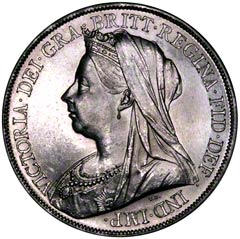
|
|
Edward VII succeded his mother Victoria in 1901, although his first coins were not issued until 1902. Our photograph shows a crown of 1902, his coronation year. This was the last crown issued which was used in general circulation. |
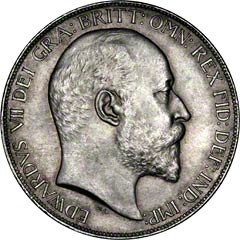
|
|
George V reigned from 1911 to 1936. During his reign, the first world war and its economic effects caused gold coins to be replaced by banknotes, and from 1920, the silver content of coins was reduced from 92.5% to 50%. |
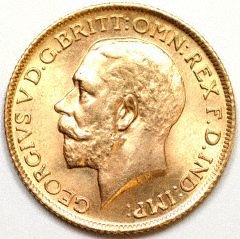
|
|
No coins bearing the portrait of Edward VIII were officially issued before or after his abdication. Our photograph shows one of a number of privately issued unofficial pattern coins. Although these are usually dated 1936 or 1937, they have been produced at various times and dates since then. |
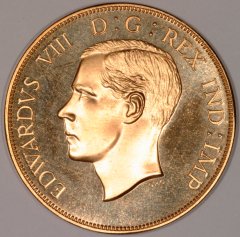
|
|
In the first year of George VI's reign, 1937, a new brass threepence was introduced as the old silver threepence was considered too small to be handled conveniently. The silver threepence was discontinued after 1944. George's reign ended with his death in 1952. |
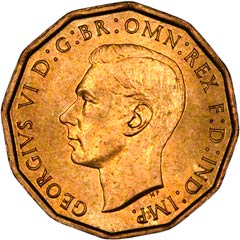
|
|
Queen Elizabeth II acceded to the throne in 1952, and was crowned in 1953. The crown illustrated was produced to commemorate her Coronation in 1953, and shows the Queen mounted on horseback, in uniform as worn for the ceremony of Trooping the Colour. |
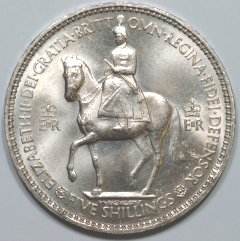
|
|
Our photograph shows the young head or first portrait of Elizabeth II on a 1960 crown issued for the New York Exhibition of that year. |
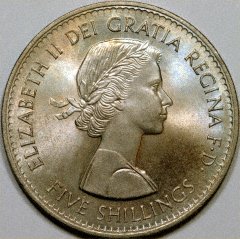
|
|
For decimalisation in 1971, a new portrait of the Queen was introduced, which was used from 1968 on the five and ten new pence coins through to 1984. We show it here on the newly introduced seven-sided fifty new pence coin, first issued in 1969. |
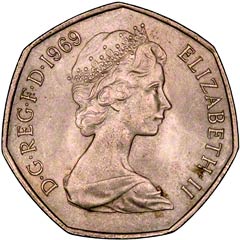
|
|
For the silver jubilee of Elizabeth II in 1977, a commemorative crown was produced with an obverse design mirroring that of the coronation crown in 1953. |
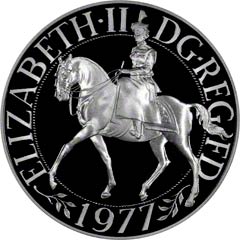
|
|
In 1985 a new, third, portrait of the Queen was introduced on all British coins, with slightly more mature features. We illustrate it here on a proof version of a one ounce gold bullion Britannia with a face value of £100. |
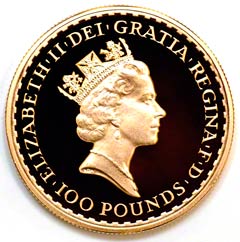
|
|
In 1989, for the five hundredth anniversary of the gold sovereign, new obverse and reverse designs were introduced on the gold sovereign, half sovereign, two pound and five pound coins. The designs on both sides of the coins reflects the designs in the original gold sovereigns issued for Henry VII in 1489, and show a majestic portrayal of the monarch seated facing. We illustrate the sovereign. |
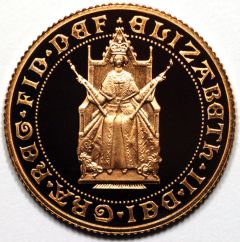
|
|
In 1997, a five pound crown was issued to celebrate the golden wedding anniversary of the Queen and Prince Philip, the Duke of Edinburgh. Our photograph shows the silver proof version. |
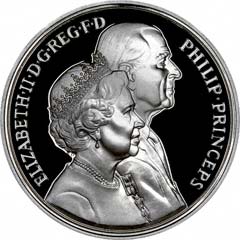
|
|
In 1998 the third portrait was replaced by a fourth design, which we show here on a year 2000 gold sovereign. |

|
|
For the 50th anniversary of her reign, this crown has a special portrait of the Queen on both obverse and reverse. The equestrian portrait recalls that on the Coronation crown, and the Silver Jubilee crown. |
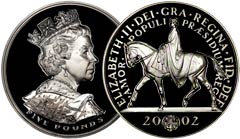
|
You may wish to visit some of our other pages:
Dates of British Monarchs
Photo Gallery of Current British Coins
World Coins Photo Gallery
Welsh Dragon on British Coins
Value of my Coin. What's it Worth?
British Coin Denominations. What's a Groat,? etc.
Common Names of British Coins. What's a Tanner?
Gold Britannia Bullion Coins
For more information about Gold Britannia bullion coins of all four sizes, and information about tax free gold, please visit out newest web site Tax Free Gold
| ...at the Lowest Possible Price |
|
32 - 36 Harrowside, Blackpool, Lancashire, FY4 1RJ, England. Telephone (44) - (0) 1253 - 343081 ; Fax 408058; E-mail: The URL for our main page is: https://24carat.co.uk | Chard(1964) Ltd |